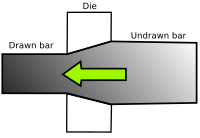
Photo from wikipedia
Abstract The increasing demand for functional-integrated lightweight components is bringing established manufacturing technologies to their limits and motivates research into the innovative process class of sheet-bulk metal forming (SBMF). By… Click to show full abstract
Abstract The increasing demand for functional-integrated lightweight components is bringing established manufacturing technologies to their limits and motivates research into the innovative process class of sheet-bulk metal forming (SBMF). By applying bulk forming operations to sheet metal, thin-walled components with integrated functional elements can be produced in short process chains by a three dimensional material flow. Currently, pre-cut blanks are frequently used for this purpose. Manufacturing components from coil would combine the advantages of SBMF with those of production from coil regarding high output quantities. Therefore, the objective of the present research is to develop a fundamental process understanding for SBMF of parts from coil. For this purpose, a lateral and a backward extrusion process are set up and numerically mapped for a process analysis. Known challenges in SBMF of pre-cut blanks are a limited component accuracy due to a partly uncontrolled material flow and high tool loads. Consequently, both are addressed in context of a production from coil in a combined numerical-experimental approach. An anisotropic material flow is identified as a coil-specific challenge and fundamental difference to the SBMF of blanks. It causes an unequal forming of the components. The sheet geometry as well as a local pre-hardening induced by the forming of previous parts are found to determine the anisotropic material flow. In addition, an understanding of the effects of anisotropic material flow on tool loads is developed. An unequal deflection of tools is found as a tool-specific challenge. The obtained process knowledge provides a basis for research into measures to counteract the anisotropic material flow as a central challenge of SBMF of coils in future work.
Journal Title: Cirp Journal of Manufacturing Science and Technology
Year Published: 2020
Link to full text (if available)
Share on Social Media: Sign Up to like & get
recommendations!